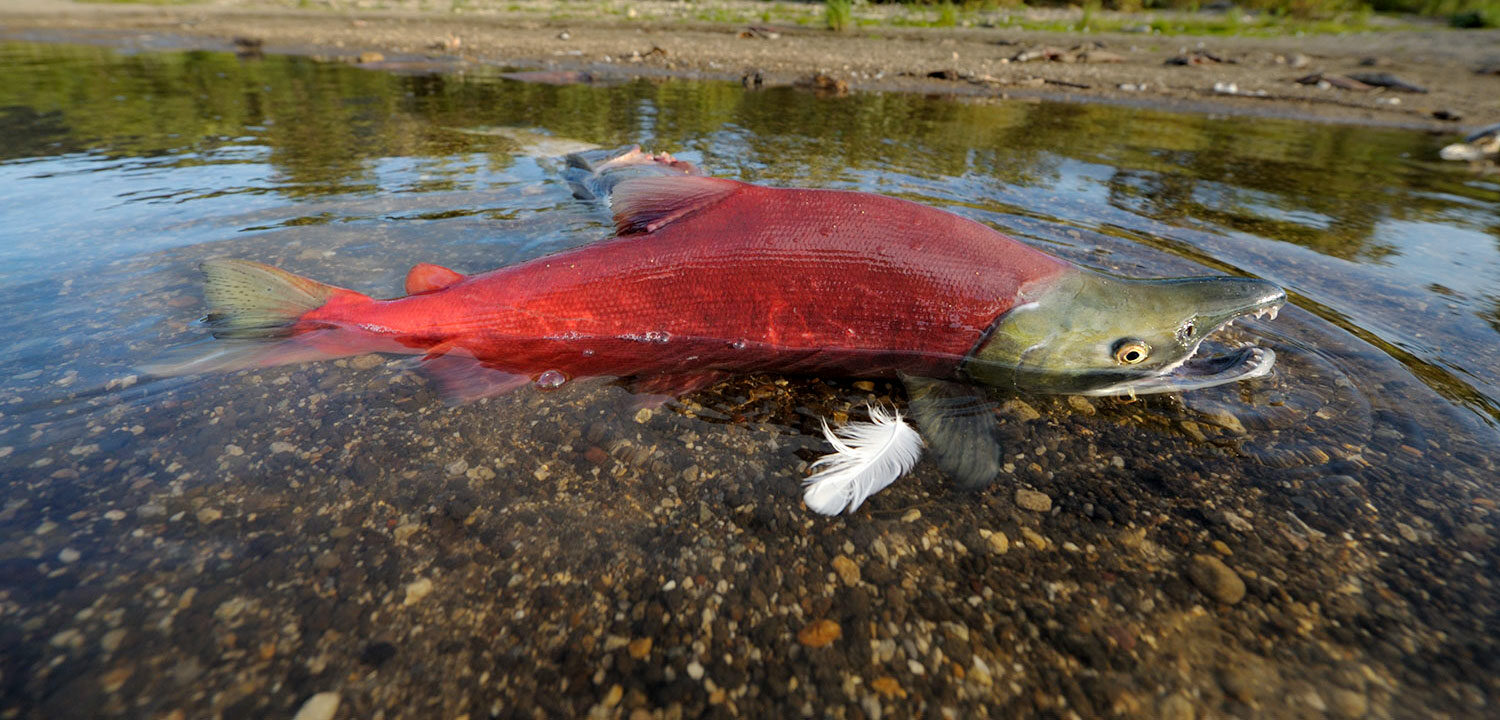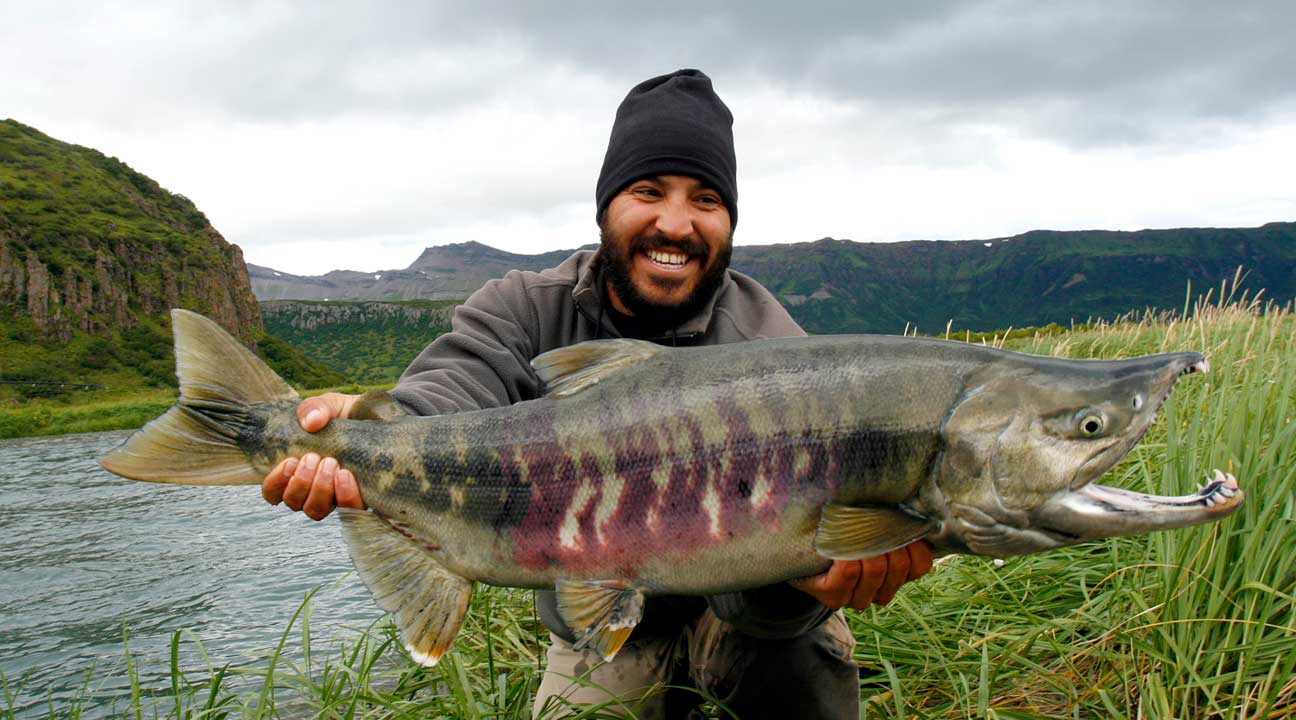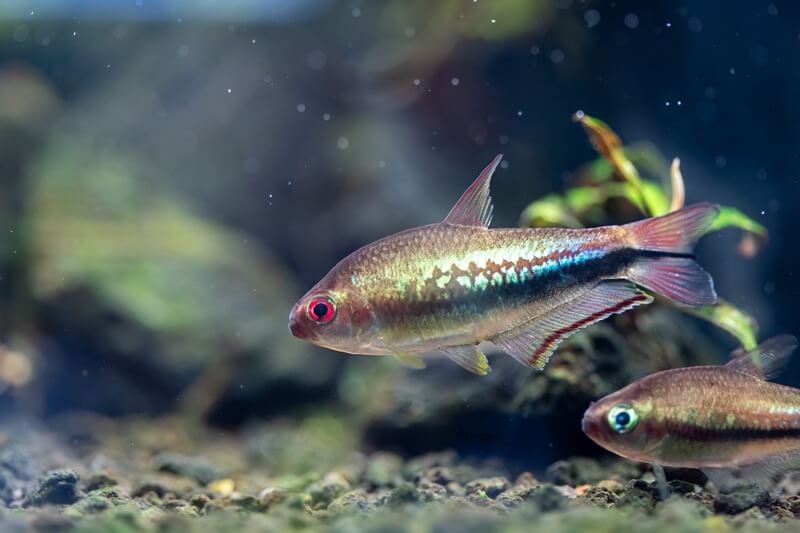Alaska is known for its abundant and diverse wildlife, and one of the most popular species is salmon. Alaska is home to five main species of Pacific salmon, each with its unique characteristics and flavor.
In this article, we will discover the five types of salmon you’ll find in Alaska, including their physical characteristics, habitat, and commercial value.
You are reading: 5 Types Of Salmon You’ll Find In Alaska
Whether you’re a fisherman, a seafood lover, or just curious about Alaska’s wildlife, this article will provide you with valuable insights into the world of salmon in Alaska.

5 Types Of Salmon You’ll Find In Alaska
Chinook Salmon
Chinook salmon, also known as King salmon, is the largest species of salmon and the least abundant. Chinook salmon are anadromous fish native to the North Pacific Ocean and the river systems of western North America, ranging from California to Alaska, as well as the Asian coast from Hokkaido, Japan to the Anadyr River area of Siberia.
In Alaska, streams normally receive a single run of Chinook salmon in the period from May through July. Chinook juveniles divide into two types: ocean type and stream type. Ocean type Chinook migrate to saltwater in their first year, while stream type spend one full year in freshwater before migrating to the ocean.
Freshwater streams and estuaries provide important habitat for spawning Chinook, and they also serve as nursery grounds for developing eggs, fry, and juveniles.
Chinook salmon are an important commercial fishery in Alaska, and their large size and high-quality flesh make them one of the most valuable species.
Coho Salmon
Coho salmon, also known as silver salmon, is a species of anadromous fish in the salmon family and one of the five Pacific salmon species.
Read more : Discover 10 Types Shocking Fish
Coho salmon are native to the North Pacific Ocean and the river systems of western North America, ranging from California to Alaska, as well as the Asian coast from Hokkaido, Japan to the Anadyr River area of Siberia.
Coho salmon are an important sport fish in Alaska and are pursued by fishermen both in marine and freshwater systems. They are also commercially harvested in the Pacific Northwest and Alaska. Coho salmon have dark metallic blue or greenish backs with silver sides and a light belly.
While they are in the ocean, they have small black spots on their back and on the upper lobe of the tail. In fresh water, spawning coho are dark with reddish-maroon coloration on the sides.
Spawning males develop a strongly hooked snout and large teeth. Coho salmon have a high oil content and appear soft when raw, but become firm and flaky when cooked.
Coho salmon populations in Alaska are healthy, but populations in California and the Pacific Northwest have experienced dramatic declines in abundance during the past several decades as a result of human-induced and natural factors.
Sockeye Salmon

Sockeye salmon, also known as red salmon or blueback salmon, is a species of Pacific salmon that is primarily red in hue during spawning. Here are some key facts about sockeye salmon:
Appearance:
– Sockeye is one of the smaller species of Pacific salmon, measuring 1.5 to 2.5 feet in length and weighing 4 to 15 pounds.
– They have bright red skin, but are actually blue while in the ocean.
– Sockeye are blue tinged with silver in color while living in the ocean. When they return to spawning grounds, their bodies become red and their heads turn green.
Habitat:
– Sockeye salmon are anadromous, meaning they migrate from freshwater to saltwater to spawn.
– They are typically found in the northern Pacific Ocean, from Alaska to Japan.
– In freshwater, sockeye salmon are found in lakes and rivers throughout the Pacific Northwest.
Fishery Management:
– Sockeye salmon are managed by the Alaska Department of Fish and Game, NOAA Fisheries, and the North Pacific Fishery Management Council.
– They are managed under the Fishery Management Plan (FMP) for Salmon Fisheries in the EEZ off the Coast of Alaska.
– U.S. wild-caught sockeye salmon is a smart seafood choice because it is sustainably managed and responsibly harvested under U.S. regulations.
Commercial Value:
– Sockeye salmon is the premium Pacific salmon species in the international marketplace, selling for more per pound than all Pacific salmon but Chinook.
– Sockeye meat is tinted orange due to their prolific consumption of red krill during their time at sea, and their highly desirable flavor makes them the focus of many fisheries.
– Sockeye salmon is low in sodium and is a good source of omega-3 fatty acids.
Sockeye salmon is an important species in Alaska, both commercially and ecologically. Its bright red flesh and rich flavor make it a popular choice for seafood lovers, and its sustainable management ensures that it will continue to be a valuable resource for years to come.
Pink Salmon
Pink salmon, also known as humpy salmon, is the smallest and most abundant of the seven officially recognized species of salmon. Here are some key facts about pink salmon:
Appearance:
– Pink salmon are the smallest of the Pacific salmon found in North America, weighing between 3.5 and 5 pounds, with an average length of 20 to 25 inches.
– They can be distinguished from other Pacific salmon by the large dark oval spots on their back and entire tail fin as well as their general coloring and form.
– In the ocean, pink salmon are steel blue to blue-green on the back, silver on the sides, and white on the belly.
– During their spawning migration, males develop a pronounced humped back, hence their nickname “humpies”.
Habitat:
– Pink salmon are found along the Pacific rim of Asia and in North America, from the Sacramento River in northern California to the Mackenzie River in Canada, and from the Lena River in Siberia to Korea and Honshu in Japan.
– They are the most numerous Pacific salmon and have been harvested and canned commercially in Alaska since the late 1800s.
– Pink salmon are anadromous, meaning they migrate from freshwater to saltwater to spawn.
Fishery Management:
– Pink salmon are managed by the Alaska Department of Fish and Game, NOAA Fisheries, and the North Pacific Fishery Management Council.
– They are managed under the Fishery Management Plan (FMP) for Salmon Fisheries in the EEZ off the Coast of Alaska.
– U.S. wild-caught pink salmon is a smart seafood choice because it is sustainably managed and responsibly harvested under U.S. regulations.
Commercial Value:
– Pink salmon is not considered as desirable as other salmon species, mostly because the shorter lifespan of pink salmon results in a less fatty and less flavorful meat.
– Pink salmon is low in oil content, so it’s generally lean and mild-flavored.
– Pink salmon is available fresh from late summer to fall, and frozen and canned year-round.
– Pink salmon is a very important fishery species throughout its range, and tens of millions (if not hundreds of millions) of individuals are captured by net fisheries each year.
Pink salmon is an important species in Alaska, both commercially and ecologically. Its abundance and availability make it a popular choice for canned salmon, and its sustainable management ensures that it will continue to be a valuable resource for years to come.
Chum Salmon

Chum salmon, also known as dog salmon or keta salmon, is one of the largest species of Pacific salmon, second only to Chinook salmon in size. Here are some key facts about chum salmon:
Appearance:
– Chum salmon are metallic greenish-blue along the back with black speckles, similar to both sockeye and coho salmon, when in the ocean.
– As adult chum salmon enter freshwater to spawn, both sexes’ color and appearance change dramatically. Males develop large canine teeth and a hooked snout, and their bodies turn a deep red or purple color. Females develop a dark vertical stripe on their sides and a greenish-blue color on their backs.
– Chum salmon have a highly forked tail, more so than other species of Pacific salmon, and is not spotted. The tail also has silver streaks along (but not between) the fin rays.
Habitat:
– Chum salmon are the most widely distributed of all the Pacific salmon and generally occur throughout Alaska.
– They range throughout the North Pacific Ocean, from the Sacramento River in California to the Lena River in Russia.
– Chum salmon are anadromous, meaning they migrate from freshwater to saltwater to spawn.
Fishery Management:
– Chum salmon are managed by the Alaska Department of Fish and Game, NOAA Fisheries, and the North Pacific Fishery Management Council.
– They are managed under the Fishery Management Plan (FMP) for Salmon Fisheries in the EEZ off the Coast of Alaska.
– U.S. wild-caught chum salmon is a smart seafood choice because it is sustainably managed and responsibly harvested under U.S. regulations.
Commercial Value:
– Chum salmon is the least commercially valuable salmon in North America, despite being extremely plentiful in Alaska.
– Chum salmon is often used for canning, smoking, and making salmon roe.
– Chum salmon is also used for subsistence purposes by Alaska Native communities.
Chum salmon is an important species in Alaska, both commercially and ecologically. Its abundance and availability make it an important resource for subsistence purposes, and its sustainable management ensures that it will continue to be a valuable resource for years to come.
FAQS
1. What are the five types of salmon in Alaska?
The five types of salmon in Alaska are Chinook (King), Coho (Silver), Sockeye (Red), Pink (Humpy), and Chum (Dog or Keta).
2. Which is the largest species of salmon in Alaska?
Chinook salmon, also known as King salmon, is the largest species of salmon in Alaska.
3. Which is the most abundant species of salmon in Alaska?
Pink salmon, also known as Humpy salmon, is the most abundant species of salmon in Alaska.
4. Which salmon species is the most commercially valuable in Alaska?
Sockeye salmon, also known as Red salmon, is the most commercially valuable salmon species in Alaska.
5. Are all five species of salmon found in the same areas of Alaska?
Yes, all five species of salmon can be found in various areas of Alaska, although some species are more prevalent in certain regions than others.
6. Are all five species of salmon equally desirable for eating?
No, some species of salmon are considered more desirable for eating than others due to differences in flavor, texture, and oil content. For example, Sockeye salmon is considered a premium species due to its high oil content and rich flavor, while Pink salmon is considered less desirable due to its lower oil content and milder flavor.
7. Are all five species of salmon sustainably managed in Alaska?
Yes, all five species of salmon are sustainably managed in Alaska by the Alaska Department of Fish and Game, NOAA Fisheries, and the North Pacific Fishery Management Council. U.S. wild-caught salmon is a smart seafood choice because it is responsibly harvested under U.S. regulations.
Source: https://petstutorial.com
Category: Animals










